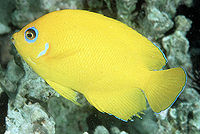Difference between revisions of "Centropyge flavissimus"
From The Aquarium Wiki
m |
(No difference)
|
Revision as of 15:27, 21 August 2016
Lemonpeel Angelfish
Centropyge flavissimus
114 Litres (30 US G.)
10.2-15.2cm (4-6 ")
8.1 - 8.5
22.2-25.6°C (72 -78 °F)
8-12 °d
1:0 M:F
5-10 years
Family
Pomacanthidae
This animal is available captive bred
Contents
Additional names
- Lemonpeel Angelfish
Additional scientific names
- Holacanthus flavissimus, Centropyge flavissima
Origin
- The Lemonpeel Angelfish ranges from the Indo-Pacific region to Christmas Islands. This fish was also found is the Hawaiian Islands, but is uncommon there.
Sexing
- The Lemonpeel Angelfish is a tropical saltwater fish, so if you want to breed them buy two Angels at the same time and let them pair off. Lemonpeel spawning happens at night and are all born as females. If another is added, one will change to become a male!
Tank compatibility
- Lemonpeel Angelfish are very easy going when it comes to compatibility! These fish should not be kept with Lemonpeel mimic tang, Those tangs look much like their own species. They also don't get along well with their own species, unless in tanks over 150 gallons. Fish like sailfin tangs, wrasse, clowns, and basslets make great compatible tank mates. Lemonpeels should not be kept with damsels, overly aggressive fish or in a reef tank!
Diet
- Feed the Lemonpeel Angelfish pellets and flakes, also feed frozen and live food.
Feeding regime
- Feed these fish 1-2 times to day for a adult for a juveniles feed them 2-3 times per day.
Environment Specifics
- The Lemonpeel's tanks should have various pieces of live rock. Both gravel and sand are recommended. Do not keep with corals or inverts.
Behaviour
- These fish are semi-aggressive and will pick on corals and frags. Weaker fish may be picked on too. Never put two dwarf angels in a tank under 568 Litres (150 US G.) or with a mimic tang representing the angels species!
Identification
- Lemonpeel Angelfish are a bright yellow, with neon blue ring around the eyes and the tail fins, there is also blue around the gill cover.
Species Note
- Hybrids of C. flavissimus have been seen in the trade, particularly a hybrid with Centropyge vroliki. This hybrid retains the characteristic blue eyeliner of C. flavissimus with the dark caudal fin of the C. vroliki. Being a hybrid, the colours will vary.
Pictures
External links
- Fishbase (Mirrors:
 )
)
